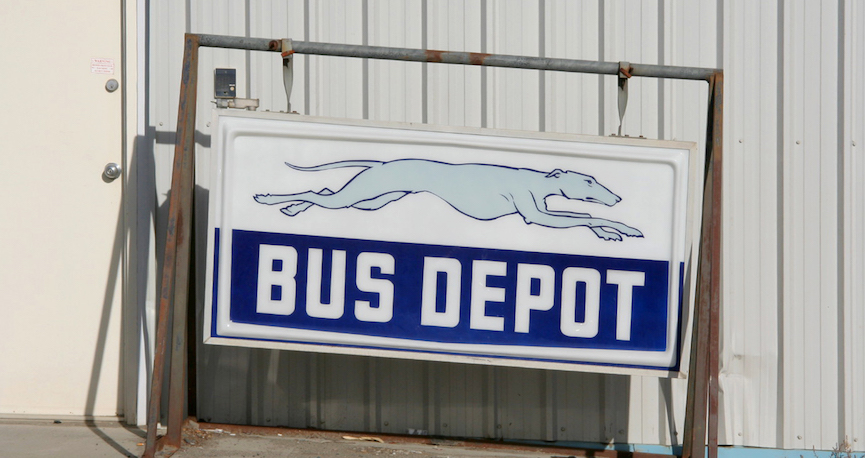You’ve probably heard the news: Greyhound Canada is pulling all intercity bus services, including passenger and freight routes, from British Columbia, Alberta, Saskatchewan, and Manitoba within the next three months. The move leaves much of Western Canada’s rural population without access to affordable, reliable, or safe public transportation. And in Saskatchewan, where the provincial government’s austerity measures closed down the Saskatchewan Transportation Company last year, nary a bus route remains.
The impact of Greyhound’s decision cannot be understated. From jeopardizing the possibility of rural rejuvenation, family farming, and food sovereignty to aggravating the ongoing crisis of missing and murdered Indigenous women, the dearth of low-cost transportation options in Western Canada will penalize people with low incomes, Indigenous communities, and rural families. Duncan Cameron reminds us that the decision will also contribute to Canada’s economic disintegration; transporting goods across the region will now be harder and more expensive.
The announcement, which Greyhound ultimately blamed on a 41 per cent decline in ridership from 2010 onwards, came as no surprise. The corporation has engaged in a series of cost-cutting measures and frequency adjustments to bus routes over the years, and now maintains that its western services are simply “unsustainable.”
But in a certain sense, anger directed at Greyhound is misplaced. Corporations care about their bottom line, not people. If Greyhound turned around tomorrow and reneged on the decision, the underlying problem would remain. If another for-profit bus company came in and filled the transit void, the underlying problem would still remain. No private sector remedy will solve the underlying problem, which is that transit is still not understood to be a human right.
The Canadian Human Rights Commission and its parallel provincial bodies recognize that transportation must be accessible to everyone, especially when it comes to disability rights. The UN Universal Declaration of Human Rights’ Article 13.1 maintains that “everyone has the right to freedom of movement and residence within the borders of each State.” And Article 21.2 avows that “everyone has the right to equal access to public service in his country.” But what happens when transportation isn’t a robust public service, and not everyone can afford to realize their right to freedom of movement?
The solution to the Greyhound dilemma, and indeed to all transit-adjacent issues, necessarily lies with the public sector. If human rights are about equitable access, as Liz Majic of Canada Without Poverty assures us, then it’s time for a national transportation plan. Because the only way to ensure equitable access is if a body motivated by humans and human rights, and not by profit, oversees transportation. So, let’s avoid a race to the bottom and use the Greyhound decision as a moment to organize strategically around our right to transit.
And hopefully, after the Supreme Court’s recent decision that charities are free to engage in partisan political activities — in a challenge brought by Canada Without Poverty no less! — we’ll have some weight behind the movement. Onwards!
In other rabble news
Our Ontario Fightback series continues to amplify the voices of a growing coalition of activists and citizens mobilizing to confront Premier Ford’s regressive, reactionary agenda. This week, Ontario Fightback curated a series of insights around strategies for resisting Ford, gleaned from panels organized with Briarpatch Magazine, the Council of Canadians, Solidarity Ottawa, and the Fight for $15 and Fairness. From the meaning of solidarity to tactics for working effectively with the ONDP and tools for organizing, Ontario Fightback inspires action and hope for alternatives. You can read the “tl;dr” or watch the panels yourself.
The Assembly of First Nations will hold its election for national chief in one week. While the AFN elections are generally underreported outside of a handful of Indigenous media outlets and disregarded in mainstream political circles, this year’s election will bring a critical juncture for Indigenous communities. The election boils down to a contest between Indigenous leaders who accept the federal government’s legislative framework, which Pamela Palmater points out “only works if First Nations don’t assert their rights,” and those who reject it, in favour of real reconciliation: the return of some lands, a share in natural resources, and sovereignty. Read more about what’s at stake for Indigenous communities and our shared planet.
Thanks for reading rabble’s weekly roundup. Stay tuned for more news for the rest of us.
Sophia Reuss is rabble.ca’s Assistant Editor.
Image: Amanda Graham/Flickr
Like this article? rabble is reader-supported journalism. Chip in to keep stories like these coming.




